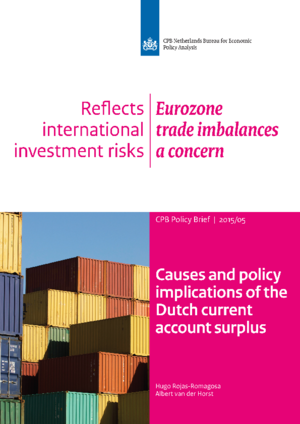Causes and policy implications of the Dutch current account surplus
Dutch current account surplus is at most a Eurozone issue
The surplus is mainly explained by structural factors, of which two stand out: the relatively high savings and foreign investments by multinational enterprises and pension funds, and the internationalisation of the Dutch economy, including Eurozone membership.
There is no reason for immediate unilateral policy action by the Dutch government, according to researchers Hugo Rojas-Romagosa and Albert van der Horst of CPB Netherlands Bureau for Economic Policy Analysis (CPB), in the CPB Policy Brief Causes and Policy Implications of the Dutch Current Account Surplus published today. Yet, the increasing intra-Eurozone Dutch trade surplus does signal the need for policy action at the Eurozone level.
The savings and investment behaviour of multinational enterprises and pension funds does not point directly to market or policy failures that must be addressed by policy makers. The current account surplus, therefore, is not a problem in itself. However, the surplus may point to some underlying problems that may require policy action on their own. An indirect cause for concern are the valuation risks associated with a large gross and net international investment position (NIIP) of the Dutch. The accumulated stock of foreign assets is vulnerable to valuation losses due to fluctuations in international financial markets and exchange rate risks. In the past, these factors have generated significant losses – a feature that was labelled as the ‘black hole’.
The increase in Dutch surplus from average values of 3% before the 2000s and 6% afterwards is directly associated with an increase in the Dutch bilateral trade surplus with other Eurozone countries. This fact has not been highlighted so far by previous studies, nor by the Macroeconomic Imbalances Procedure of the European Commission. It amounts to approximately two-thirds of the overall Dutch trade surplus. From a European perspective, these bilateral trade imbalances signal a lack of effective adjustment mechanisms within the euro. However, these can only be addressed effectively at the Eurozone level, which appears unlikely in the short term.
The current account surplus is defined in two ways. From the trade side it is the difference between exports and imports (plus net income and transfers). From the financial side it is the difference between overall savings and domestic investments.
Read also the accompanying press release and the following CPB Background Documents:
- Bilateral trade balances for the Netherlands and eight selected countries: Comparing gross and value added trade statistics and data sources
- Literature survey on the theoretical explanations and empirical determinants of current account balances
- Facts and figures on the Dutch current account surplus
The Dutch current account surplus is mainly explained by structural factors, of which two stand out: the relatively high savings and foreign investments by multinational enterprises and pension funds, and the internationalisation of the Dutch economy (including Eurozone membership).
The savings and investment behaviour of multinational enterprises and pension funds does not point directly to market or policy failures that must be addressed by economic policy. The current account surplus, therefore, does not seem to be a problem in itself, although it might signal underlying problems. For example, large household savings are related to pension funds and housing market imperfections, which in their own right may merit policy action.
The main cause for concern for the Dutch government are the valuation risks associated with a large gross and net international investment position (NIIP). The accumulated stock of foreign assets is vulnerable to valuation losses due to fluctuations in international financial markets and exchange rate risks. In the past, these factors have generated significant losses — a feature that was labelled as the Dutch “black hole”.
The large Dutch surplus can be directly associated with diverging intra-Eurozone trade patterns since the 2000s. From a European perspective, the increasing bilateral trade imbalances — generated by the dynamics of a fixed nominal exchange rate, joint monetary policy through the ECB and the lack of effective adjustment mechanisms — represent an important economic policy concern. This issue, however, can only be addressed effectively by the Dutch government in coordination with other Eurozone members.
